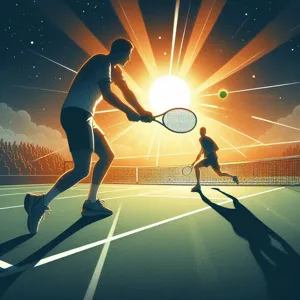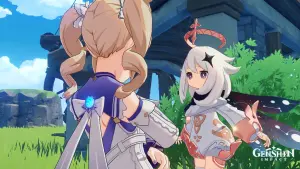In the dynamic world of basketball, the point guard stands as a pivotal player, often referred to as the “floor general” for good reason.
This position demands a unique blend of skills, intuition, and leadership that can make or break a team’s success on the court. A great point guard not only orchestrates the offense but also possesses the ability to read the game, communicate effectively with teammates, and make split-second decisions under pressure. From court vision and ball-handling finesse to defensive prowess and a strong work ethic, mastering the essential qualities of an exceptional point guard requires dedication and passion. In this blog post, we’ll delve into the key attributes that define the best point guards in basketball history and provide insights on how aspiring players can develop their skills to elevate their game and truly master the court. Whether you’re a budding athlete or an enthusiastic fan, understanding these qualities will deepen your appreciation for this crucial role in the sport.
1. Introduction: The Role of a Point Guard in Basketball

In the fast-paced world of basketball, the point guard stands as the heartbeat of the team. Often referred to as the “floor general,” this player assumes a pivotal role, orchestrating the offense while ensuring fluid communication and synergy among teammates. A point guard is not merely a shooter; they are the strategic backbone of the squad, responsible for setting the tempo and making split-second decisions that can alter the course of the game.
Possessing a unique combination of skills, an exceptional point guard excels in ball-handling, passing accuracy, and court vision. They must navigate the intricate dynamics of the game with finesse, understanding not only their own strengths but also the capabilities and tendencies of their teammates. A great point guard can read the defense like a seasoned poet, anticipating movements and exploiting weaknesses to create scoring opportunities.
Moreover, the role goes beyond technical prowess. An outstanding point guard embodies leadership and confidence, rallying the team during crucial moments and maintaining composure under pressure. They must also be adaptable, capable of shifting strategies on the fly based on the opposing team’s tactics. Ultimately, the point guard is not just a player; they are the linchpin that holds the team together, driving both offense and defense while leaving a lasting impact on the game.
In this blog post, we will delve deeper into the essential qualities that define an exceptional point guard, exploring the skills, mindset, and dedication required to master this critical position on the basketball court. Whether you’re a player aspiring to excel or a fan eager to understand the nuances of the game, understanding the role of the point guard is key to appreciating the artistry of basketball.
2. Basketball IQ: Understanding the Game
Basketball IQ is the cornerstone of an exceptional point guard and often separates the good from the great on the court. This innate understanding of the game goes beyond basic skills and includes the ability to read the flow of play, anticipate opponents’ moves, and make split-second decisions that can change the outcome of a game. A point guard with high basketball IQ is akin to a chess master, always thinking several steps ahead.
Understanding the nuances of offensive and defensive strategies is vital. A savvy point guard can assess the strengths and weaknesses of both their team and the opposition, adjusting their play style accordingly. This means knowing when to push the pace in transition, when to slow things down to maintain control, and how to exploit mismatches effectively. They should be adept at recognizing defensive schemes, whether it’s a full-court press, a zone defense, or man-to-man, and adjust their approach to counteract these strategies.
Moreover, exceptional point guards possess a deep knowledge of their teammates’ abilities. They understand who thrives in isolation, who excels in pick-and-roll situations, and who prefers to shoot from the perimeter. This awareness allows them to distribute the ball more effectively, setting up teammates for high-percentage shots while maintaining the overall rhythm of the offense.
An exceptional point guard also exhibits a strong understanding of game situations—knowing when to take a shot, when to pass, and when to run down the clock. This situational awareness is crucial during tight games and can be the difference between victory and defeat.
In summary, basketball IQ encompasses a point guard’s ability to analyze, strategize, and execute, making it one of the most essential qualities for anyone looking to master the position. With a strong basketball IQ, point guards not only elevate their own game but also inspire and enhance the performance of their entire team.
3. Leadership on the Court: Guiding Your Team

Leadership on the Court: Guiding Your Team
One of the most defining qualities of an exceptional point guard is their ability to lead on the court. This role transcends mere skill in dribbling or shooting; it encapsulates the essence of being a team orchestrator, a strategist, and a source of inspiration. A point guard is often referred to as the “floor general,” and for good reason. They are tasked with making split-second decisions that can change the course of a game and must communicate effectively with teammates to implement those strategies.
A great point guard possesses an innate ability to read the game, understanding not just their own role but also the strengths and weaknesses of each player on the team. This situational awareness allows them to direct plays, create opportunities, and adjust tactics in real-time. Whether it’s calling for a pick-and-roll or directing traffic during a fast break, their vocal presence is crucial in ensuring that everyone is on the same page.
Moreover, leadership is not solely about making calls; it’s about fostering trust and camaraderie within the team. An exceptional point guard leads by example, demonstrating work ethic, resilience, and sportsmanship both in practice and during games. They uplift their teammates, providing encouragement after mistakes and celebrating successes, which cultivates a positive atmosphere. This emotional intelligence is what sets great point guards apart; they know when to push their teammates and when to lend a supportive hand.
In high-pressure situations, a strong leader remains calm and composed, instilling confidence in their teammates. They serve as a stabilizing force, often taking charge during critical moments, whether it’s managing the clock in a close game or executing a last-second play. Ultimately, the ability to guide a team not only enhances the performance of individual players but also elevates the entire squad, making the point guard an invaluable asset on and off the court.
4. Communication Skills: The Key to Effective Team Play
Effective communication is the lifeblood of any successful basketball team, and as the point guard, you are often considered the on-court leader. Your ability to articulate plays, strategize in real time, and foster an environment of trust and collaboration is critical to not only your performance but also that of your teammates. Exceptional point guards excel at verbal communication, using clear and concise language to relay important information quickly during the heat of the game. This could mean calling out a specific play, alerting teammates to defensive switches, or encouraging them to take a shot when the opportunity arises.
But communication extends beyond just words; it encompasses nonverbal cues as well. A well-timed gesture or a knowing glance can convey volumes, allowing for seamless interactions without disrupting the flow of the game. For instance, a simple nod can signal a teammate to set a screen, while an eye contact can indicate it’s time to execute a fast break. Understanding and anticipating the needs of your teammates is crucial, and this level of intuition stems from building strong relationships both on and off the court.
Moreover, fostering open lines of communication encourages an atmosphere of accountability and support. As a point guard, it’s your responsibility to instill confidence in your teammates, helping them to feel secure in their roles. Constructive feedback, delivered with respect and positivity, can inspire players to elevate their game and contribute more effectively to the team’s objectives. This collaborative spirit not only enhances performance but also deepens team chemistry, making your squad more formidable against any opponent.
In essence, mastering communication skills is about more than just directing traffic on the court; it’s about creating a cohesive unit that thrives on trust, understanding, and shared goals. When you excel in this area, you not only elevate your own game but also empower your teammates to reach their fullest potential.
5. Vision and Awareness: Reading the Game

Vision and awareness are the cornerstones of an exceptional point guard’s skill set. A great point guard doesn’t just see the game; they anticipate it. This keen sense of awareness allows them to read not only their teammates’ movements but also the defensive setups of their opponents. It’s akin to playing chess on a basketball court, where every decision made in a split second can alter the outcome of a play.
Exceptional point guards have an innate ability to scan the court, identifying mismatches and openings that others might overlook. Their peripheral vision enables them to keep track of multiple players simultaneously, ensuring they’re always one step ahead. This heightened awareness is often cultivated through experience and a deep understanding of game dynamics—knowing when to push the tempo, when to slow things down, and how to exploit defensive weaknesses.
Moreover, this quality extends beyond mere observation. It involves communication and leadership—an exceptional point guard can read the body language of their teammates, gauging when someone is ready to receive a pass or when a player might need encouragement. They orchestrate the offense like a conductor leading a symphony, calling out plays, and redirecting traffic as necessary.
In practice, this means constantly being aware of the clock, the score, and the emotions of the game. A great point guard thrives under pressure, using their vision to navigate through chaotic situations, whether it’s threading a needle with a pass through a crowded lane or recognizing an opportunity for a fast break. When a point guard possesses this unique blend of vision and awareness, they become a pivotal force on the court, capable of transforming the flow of the game and inspiring their team to elevate their performance.
6. Ball Handling: The Art of Control
Ball handling is more than just a skill; it’s an art form that distinguishes exceptional point guards from the rest. A point guard’s ability to control the ball not only facilitates effective playmaking but also instills confidence in their teammates. This essential quality encompasses a variety of techniques, from dribbling to passing, each requiring precision, creativity, and poise under pressure.
An exceptional point guard has an innate ability to protect the ball while navigating through defenders. They use a low center of gravity to execute quick crossovers, hesitations, and behind-the-back dribbles, creating space and opportunities for themselves and their teammates. With a deft touch, they can change directions in an instant, making it difficult for opponents to predict their next move. This agility is not merely about flashy tricks; it’s about maintaining control while reading the defense and making split-second decisions that can shift the momentum of the game.
Moreover, a point guard’s ball handling extends beyond mere dribbling. It involves making accurate, timely passes that connect with teammates in stride. Whether it’s a bounce pass threading through traffic or a no-look feed that catches a defender off guard, the ability to deliver the ball effectively can turn an average offensive play into a highlight reel moment. The best point guards develop a sixth sense for what their teammates need, anticipating their movements and ensuring they receive the ball in a position to score.
In addition to technical skills, mental acuity plays a crucial role in ball handling. A top-tier point guard must remain composed in high-pressure situations, avoiding turnovers while orchestrating the offense. They must be aware of the game clock, shot clock, and the positioning of both teammates and opponents. This situational awareness allows them to make smart decisions, whether it’s to slow the pace down, push for a fast break, or create a high-percentage shot.
Ultimately, mastering the art of ball handling requires dedication, practice, and a love for the game. By honing their skills and maintaining a strong connection with their teammates, exceptional point guards not only elevate their own performance but also enhance the overall dynamics of their team, making them invaluable assets on the court.
7. Passing Skills: Setting Up Teammates for Success

Passing skills are the heartbeat of a point guard’s game, serving as the crucial link that connects individual effort with team success. An exceptional point guard possesses the uncanny ability to read the court, anticipating not only where the ball needs to go but also how to deliver it in a way that maximizes the potential for scoring. This requires a blend of vision, timing, and precision.
Visualize a point guard gliding down the court, eyes scanning the floor like a hawk. They see the play unfolding, recognizing mismatches and open lanes that even the casual observer might miss. With a flick of the wrist or a deft bounce pass, they can deliver the ball to a teammate at just the right moment, turning what could be a missed opportunity into a highlight-reel play. Whether it’s a no-look pass that catches defenders off guard or a lob over the top for a soaring dunk, each pass is a testament to their court awareness.
Moreover, an exceptional point guard understands the importance of communication. They are often the vocal leader on the floor, calling plays and directing traffic to ensure their teammates are in the optimal position to receive the ball. This guidance not only helps in executing plays but also fosters a strong sense of teamwork and trust, essential ingredients for a cohesive unit.
But passing is not just about technique; it’s also about creativity and adaptability. The best point guards can think outside the box, finding unconventional ways to deliver the ball. They thrive in high-pressure situations, where split-second decisions can alter the course of the game. This adaptability allows them to tailor their passing style to the strengths of their teammates, ensuring that every player feels empowered to contribute.
In essence, passing skills are more than just a fundamental aspect of a point guard’s toolkit; they are a reflection of their understanding of the game and their commitment to their teammates’ success. When a point guard excels in this area, they not only elevate their own performance but also transform the entire team’s play, making them a pivotal force on the court.
8. Scoring Ability: Balancing Playmaking and Scoring
Scoring ability is a crucial attribute for any exceptional point guard, as it encapsulates the delicate balance between playmaking and personal scoring. A point guard is often seen as the floor general, orchestrating the offense and dictating the tempo of the game. However, this role extends beyond just facilitating plays; the ability to score effectively can elevate a point guard’s impact on the game significantly.
An exceptional point guard must possess a versatile scoring arsenal. This includes a reliable jump shot, the ability to finish at the rim with finesse, and the agility to create their own shot. A solid mid-range game can be a game-changer, allowing them to exploit defensive lapses and keep defenders guessing. Moreover, a point guard who can shoot from beyond the arc adds another layer of danger, stretching the floor and creating driving lanes for teammates.
Yet, scoring does not come at the expense of playmaking. The best point guards know when to take over the game and when to facilitate for others. They read defenses like a quarterback reading a blitz, quickly assessing whether to drive, dish, or shoot. This dual threat keeps defenses on their toes, as they cannot afford to sag off, lest they allow an open shot, and they cannot commit too heavily to the ball handler, risking a well-placed assist to an open teammate.
Additionally, scoring ability can bolster a point guard’s leadership on the court. When a point guard is unafraid to take the big shot, it instills confidence in the entire team. Players rally around a leader who can step up in clutch moments, creating a winning mentality that permeates the roster.
In essence, the scoring ability of a point guard is not just about putting points on the board; it’s about enhancing the overall effectiveness of the team. Striking the perfect balance between playmaking and scoring ensures that a point guard can adapt to the flow of the game, making them an invaluable asset in mastering the court.
9. Defensive Skills: The Importance of Two-Way Play
In basketball, the role of a point guard transcends beyond orchestrating the offense; it demands a robust defensive presence that can significantly influence the game. Exceptional point guards understand that their responsibilities extend to the other side of the court, where defensive skills become just as crucial as offensive prowess. A great point guard must be a relentless defender, capable of applying pressure on opposing ball handlers, disrupting plays, and creating turnovers.
Defensive acumen starts with anticipation and awareness. An outstanding point guard reads the game, scanning both the ball and their opponents, quickly identifying potential threats. This keen sense of the game allows them to react swiftly, whether it’s stepping into passing lanes or anticipating a drive to the basket. They must possess quick lateral movement and agility, enabling them to stay in front of their man and contest shots effectively.
Moreover, an exceptional point guard engages in two-way play, demonstrating the ability to seamlessly transition from defense to offense. After a defensive stand, they must quickly capitalize on the opportunity to push the ball upcourt, turning a defensive rebound into a fastbreak. This transition is critical, as it can catch the opposing team off guard and create scoring opportunities.
Additionally, communication is a linchpin in defensive strategy. A great point guard must vocalize their observations, directing teammates and ensuring everyone is on the same page. Whether calling out screens, switching on defense, or alerting teammates about an open shooter, their leadership is vital in maintaining a cohesive defensive unit.
In sum, the importance of defensive skills in a point guard’s arsenal cannot be overstated. A player who excels on both ends of the floor not only elevates their game but also sets a standard for their team, fostering a culture of toughness and resilience. Mastering this two-way play is essential for any aspiring point guard aiming to leave a lasting impact on the court.
10. Work Ethic and Training: Committing to Improvement
When it comes to the role of a point guard, sheer talent alone isn’t enough to excel; it is the relentless work ethic and dedication to training that truly defines an exceptional player. A great point guard understands that each practice session is an opportunity for growth, a chance to refine skills, and a moment to elevate their game to new heights. This commitment to improvement manifests in various ways, from early morning workouts to late-night shooting sessions.
An exceptional point guard embraces the grind, demonstrating discipline in their training regimen. They delve into the intricacies of ball handling, tirelessly practicing dribbling drills that enhance their control and agility. They study the game, analyzing film not just of their own performances, but also of legendary point guards who have paved the way. This dedication isn’t limited to physical training; it also encompasses mental preparation. A point guard must be able to read defenses, anticipate plays, and make split-second decisions under pressure.
Moreover, an unwavering work ethic extends beyond individual training. It involves fostering a strong sense of teamwork, where the point guard takes the initiative to communicate, motivate, and lead their teammates. By committing to improvement, both personally and collectively, they create a culture of excellence that permeates the entire team. Coaches and teammates alike notice the point guard who puts in extra hours at the gym, who is the last to leave the court, and who constantly strives to be better.
Ultimately, it is this relentless pursuit of excellence that separates good point guards from the truly exceptional ones. When the stakes are high and the game is on the line, it is the point guard with the strongest work ethic who rises to the occasion, ensuring that they not only master their position but also inspire those around them to elevate their own performance.
11. Adaptability: Adjusting to Different Game Situations
Adaptability is the hallmark of an exceptional point guard, embodying the ability to respond effectively to the dynamic and often unpredictable nature of a basketball game. A point guard is not just a playmaker; they are the pulse of the team, needing to read the flow of the game and make split-second decisions based on the evolving circumstances on the court. This requires a keen understanding of not only their own team’s strengths and weaknesses but also those of the opponents.
Imagine a game where the opposing team’s defense is exceptionally tight. A great point guard recognizes this and adjusts their style of play—whether that’s becoming more aggressive, driving to the basket, or exploiting mismatches by creating opportunities for teammates. Conversely, if the game calls for a more patient, methodical approach, they must have the poise to slow down the tempo, ensuring that every possession counts.
Moreover, adaptability goes beyond mere gameplay adjustments; it also encompasses the ability to handle a variety of roles within the team. Whether the point guard is required to score, facilitate, or play defensively, they must be versatile enough to switch gears seamlessly. This flexibility not only enhances their personal performance but also strengthens the synergy of the entire team.
In high-pressure situations, such as during a close game or a playoff series, the ability to adapt can be the difference between victory and defeat. An exceptional point guard thrives in these moments, adjusting strategies on the fly, whether that means stepping up as a leader, encouraging teammates, or shifting defensive assignments to counter the opponent’s best players.
Ultimately, adaptability in a point guard is about more than just the tactical adjustments; it’s about having the mental fortitude to embrace change and the foresight to anticipate it. When a point guard masters adaptability, they become an invaluable asset to their team, capable of navigating the complexities of the game and leading their team to success.
12. Building Chemistry with Teammates: Trust and Connection
Building chemistry with teammates is one of the most vital qualities of an exceptional point guard. A point guard is not just a solo player; they are the heartbeat of the team, orchestrating plays and ensuring that every player is in sync. Trust and connection are the cornerstones of effective teamwork, and fostering them can elevate a team’s performance to new heights.
An exceptional point guard cultivates trust through consistent communication, both on and off the court. During games, they must clearly convey their intentions with hand signals or verbal cues, ensuring that teammates understand their roles in the unfolding play. This level of communication builds confidence among players, allowing them to anticipate each other’s movements and make split-second decisions that can change the course of a game.
Moreover, connection goes beyond just verbal exchanges; it involves understanding each player’s strengths, weaknesses, and playing styles. A great point guard takes the time to learn how their teammates perform under pressure, what their preferred shooting spots are, and how they react in various game situations. This deep understanding enables the point guard to set up plays that maximize each player’s potential, fostering a sense of unity and purpose on the court.
Off the court, building relationships through team bonding activities can reinforce this chemistry. Whether it’s group outings, practice sessions, or simply sharing a laugh during downtime, these moments help to solidify personal connections that translate into better on-court performance. When players genuinely care for one another, it enhances their willingness to work together, share the ball, and make sacrifices for the team’s success.
In essence, a point guard who prioritizes building chemistry with teammates by nurturing trust and connection not only elevates their game but also transforms the dynamics of the entire team. This invaluable quality is what distinguishes a good point guard from a truly exceptional one, capable of leading their team through challenges and achieving greatness together.
13. Mental Toughness: Staying Focused Under Pressure
Mental toughness is a defining quality that separates exceptional point guards from the rest. In the fast-paced world of basketball, where split-second decisions can determine the outcome of a game, the ability to stay focused under pressure is paramount. Picture a critical moment in a championship game: the clock is winding down, the score is tied, and the crowd is a cacophony of noise and energy. This is where the true mettle of a point guard shines.
An exceptional point guard thrives in these high-pressure moments, maintaining clarity of thought while chaos swirls around them. They possess a unique blend of confidence and composure, enabling them to execute plays flawlessly even when the stakes are at their highest. This mental resilience is cultivated through rigorous practice, where they simulate high-pressure situations in training to prepare for the realities of the game.
Moreover, their mental toughness extends beyond just handling pressure; it involves full awareness of the game’s dynamics, an acute understanding of teammates’ strengths and weaknesses, and the ability to adapt strategies on the fly. An exceptional point guard remains level-headed, making quick decisions and communicating effectively with their teammates, ensuring everyone is aligned in the heat of the moment.
Mental toughness also includes the ability to bounce back from adversity. Whether facing a tough opponent or dealing with a personal setback, a great point guard uses these experiences as motivation to improve and elevate their game. They embody a relentless spirit, focusing on what they can control and refusing to let external circumstances dictate their performance. In essence, mental toughness is not just about surviving pressure; it’s about thriving within it, turning challenges into opportunities, and leading by example on and off the court.
14. Conclusion: The Impact of an Exceptional Point Guard
In the grand tapestry of basketball, the point guard stands as a pivotal thread, weaving together the intricate patterns of teamwork, strategy, and skill. An exceptional point guard not only possesses a diverse skill set but also embodies the qualities that elevate the entire team’s performance. Their ability to read the game, anticipate plays, and deliver precise passes transforms the court into a synchronized dance of movement and intent.
The impact of a great point guard extends beyond mere statistics; it permeates the very culture of the team. They become the on-court leader, instilling confidence in their teammates and fostering a sense of unity. Their communication skills ensure that everyone is on the same page, creating fluidity in offensive strategies and defensive maneuvers. Moreover, the mental toughness they display in high-pressure situations inspires resilience, encouraging teammates to push through adversity.
As we reflect on the essence of an exceptional point guard, it’s clear that their influence is felt long after the final buzzer sounds. From mentoring younger players to shaping the team’s identity, they leave an indelible mark on both the game and those fortunate enough to share the court with them. In mastering the art of leadership, vision, and execution, these players not only enhance their own careers but also contribute to the legacy of basketball itself. As aspiring point guards strive to emulate these qualities, they pave the way for future generations to appreciate the profound impact of this crucial position in the game.
15. Tips for Aspiring Point Guards: Developing Your Skills
Becoming an exceptional point guard requires dedication, practice, and a strategic approach to skill development. Here are some invaluable tips for aspiring point guards looking to master their craft and elevate their game:
1. **Ball Handling Proficiency**: As the primary ball handler, it’s crucial to develop exceptional dribbling skills. Spend time practicing various dribbling techniques, such as crossover moves, behind-the-back dribbles, and hesitation dribbles. Use drills that incorporate changes of pace and direction to keep defenders guessing.
2. **Court Vision**: A great point guard must possess the ability to see the entire court and anticipate plays before they unfold. Work on your peripheral vision by practicing drills that require you to keep your head up while dribbling. Additionally, watch game film to study how elite point guards read defenses and make quick decisions.
3. **Passing Skills**: The ability to deliver the ball accurately and effectively is paramount. Focus on different types of passes—bounce passes, chest passes, and overhead passes—while practicing with a teammate or against a wall. Incorporate passing drills that emphasize timing and precision, ensuring that your passes find your teammates in their shooting rhythm.
4. **Defensive Awareness**: A strong point guard must also be a tenacious defender. Work on your lateral quickness and positioning to stay in front of your opponent. Engage in one-on-one drills that challenge your defensive skills and enhance your ability to read the offensive player’s moves.
5. **Conditioning and Agility**: The role of a point guard demands high levels of stamina and quickness. Incorporate agility drills, sprinting exercises, and endurance training into your routine. Being in peak physical condition will allow you to maintain your performance throughout the game.
6. **Leadership and Communication**: As the on-court leader, developing strong communication skills is essential. Practice vocalizing your thoughts during scrimmages, calling out plays, and encouraging your teammates. A point guard should be able to rally the team and keep morale high, especially during challenging moments in a game.
7. **Learning from the Best**: Seek mentorship from experienced players or coaches who can provide guidance and share their insights. Attend camps or clinics focused on point guard play, where you can learn specialized techniques and strategies that can give you an edge.
8. **Stay Humble and Open to Feedback**: Finally, maintain a mindset of continuous improvement. Be receptive to constructive criticism and always look for ways to grow your game. Regularly set new goals for yourself, whether it involves improving your shooting percentage, refining your defensive skills, or increasing your assists per game.
By diligently focusing on these aspects, aspiring point guards can develop the essential skills that not only enhance their individual performance but also contribute significantly to their team’s success on the court.
In conclusion, mastering the court as an exceptional point guard requires a unique blend of skills, vision, and leadership qualities. As we’ve explored in this post, the ability to read the game, communicate effectively with teammates, and make quick, strategic decisions are all vital elements that set great point guards apart. By cultivating these essential traits—along with a relentless work ethic and a passion for the game—you can elevate your performance and make a lasting impact on your team’s success. So, whether you’re a player aspiring to reach new heights or a coach guiding the next generation, remember that the journey to greatness begins with dedication and a commitment to continuous improvement. Now, lace up your sneakers, hit the court, and let your point guard skills shine!






